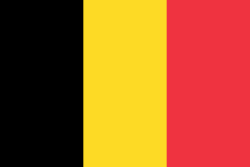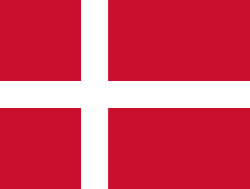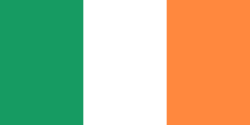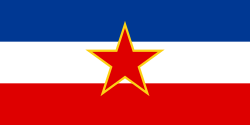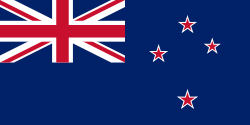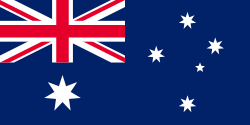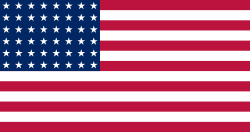Davis Cup 1947
Der Davis Cup 1947 war die 36. Ausgabe des von der ITF veranstalteten Wettbewerbes für Herrennationalmannschaften im Tennis. Der Bewerb wurde in zwei Kontinentalzonen, der Europa- und der Amerikazone, ausgetragen. Die Sieger der beiden Zonen spielten ein Playoff um den Finaleinzug.
Im Kontinentalplayoff setzte sich Australien gegen die Tschechoslowakei durch, unterlagen aber im anschließenden vom 30. August bis 1. September stattfindenden Finale Titelverteidiger USA klar mit 1:4. Es war der bisher 15. Titel der USA.
Teilnehmer
Inklusive des Titelverteidigers nahmen 23 Länder an dem Bewerb teil. Die folgenden Mannschaften spielten dabei um ein Finalticket gegen den Titelverteidiger.
Europazone
Amerikazone
Das Turnier
In den folgenden Darstellungen ist der Gastgeber einer jeweiligen Partie kursiv, sowie der Sieger fett gedruckt. Spiele ohne markiertem Gastgeber fanden auf neutralem Boden statt.
Europazone
| 1. Runde 2.–4. Mai | 2. Runde 15.–18. Mai | Viertelfinale 30. Mai–1. Juni | Halbfinale 13.–16. Juni | Finale 13.–15. Juli | ||||||||||||||||||
| Polen | ||||||||||||||||||||||
| Freilos | ||||||||||||||||||||||
| Polen | 2 | |||||||||||||||||||||
| Großbritannien | 3 | |||||||||||||||||||||
| Freilos | ||||||||||||||||||||||
| Großbritannien | ||||||||||||||||||||||
| Großbritannien | 1 | |||||||||||||||||||||
| Südafrikanische Union | 4 | |||||||||||||||||||||
| Niederlande | ||||||||||||||||||||||
| Freilos | ||||||||||||||||||||||
| Niederlande | 1 | |||||||||||||||||||||
| Südafrikanische Union | 4 | |||||||||||||||||||||
| Freilos | ||||||||||||||||||||||
| Südafrikanische Union | ||||||||||||||||||||||
| Südafrikanische Union | 2 | |||||||||||||||||||||
| Jugoslawien | 3 | |||||||||||||||||||||
| Irland | ||||||||||||||||||||||
| Freilos | ||||||||||||||||||||||
| Irland | 2 | |||||||||||||||||||||
| Jugoslawien | 3 | |||||||||||||||||||||
| Freilos | ||||||||||||||||||||||
| Jugoslawien | ||||||||||||||||||||||
| Jugoslawien | 4 | |||||||||||||||||||||
| Belgien | 1 | |||||||||||||||||||||
| Belgien | 5 | |||||||||||||||||||||
| Luxemburg | 0 | |||||||||||||||||||||
| Belgien | 4 | |||||||||||||||||||||
| Ägypten | 1 | |||||||||||||||||||||
| Spanien | 2 | |||||||||||||||||||||
| Ägypten | 3 | |||||||||||||||||||||
| Jugoslawien | 0 | |||||||||||||||||||||
| Tschechoslowakei | 4 | |||||||||||||||||||||
| Griechenland | 1 | |||||||||||||||||||||
| Schweiz | 4 | |||||||||||||||||||||
| Schweiz | 1 | |||||||||||||||||||||
| Tschechoslowakei | 4 | |||||||||||||||||||||
| Schweden | 2 | |||||||||||||||||||||
| Tschechoslowakei | 3 | |||||||||||||||||||||
| Tschechoslowakei | 5 | |||||||||||||||||||||
| Neuseeland | 0 | |||||||||||||||||||||
| Norwegen | ||||||||||||||||||||||
| Freilos | ||||||||||||||||||||||
| Norwegen | 2 | |||||||||||||||||||||
| Neuseeland | 3 | |||||||||||||||||||||
| Freilos | ||||||||||||||||||||||
| Neuseeland | ||||||||||||||||||||||
| Tschechoslowakei | 4 | |||||||||||||||||||||
| Frankreich | 0 | |||||||||||||||||||||
| Frankreich | ||||||||||||||||||||||
| Freilos | ||||||||||||||||||||||
| Frankreich | 5 | |||||||||||||||||||||
| Britisch-Indien | 0 | |||||||||||||||||||||
| Freilos | ||||||||||||||||||||||
| Britisch-Indien | ||||||||||||||||||||||
| Frankreich | 5 | |||||||||||||||||||||
| Monaco | 0 | |||||||||||||||||||||
| Monaco | ||||||||||||||||||||||
| Freilos | ||||||||||||||||||||||
| Monaco | w.o. | |||||||||||||||||||||
| Dänemark | ||||||||||||||||||||||
| Freilos | ||||||||||||||||||||||
| Dänemark | ||||||||||||||||||||||
Amerikazone
| Finale 8.–10. August | ||
| Kanada | 0 | |
| Australien | 5 | |
Playoff
Im Playoff zwischen den beiden Siegern der Kontinentalzonen siegte Australien über die Tschechoslowakei.
| ||||
| Ergebnis | ||||
|---|---|---|---|---|
| John Bromwich | Vladimír Černík | 6:1, 6:1, 6:1 | ||
| Dinny Pails | Jaroslav Drobný | 3:6, 4:6, 6:4, 4:6 | ||
| John Bromwich Colin Long | Vladimír Černík Jaroslav Drobný | 6:2, 6:2, 6:2 | ||
| John Bromwich | Jaroslav Drobný | 6:2, 7:5, 6:4 | ||
| Dinny Pails | Vladimír Černík | 6:3, 4:6, 3:6, 6:2, 6:3 | ||
Finale
Im Finale zwischen Titelverteidiger USA und Australien konnten sich die USA klar mit 4:1 durchsetzen. Es war der bisher 15. Titel der USA.
| USA | Finale[2] | Australien | |||||||||||||||
|---|---|---|---|---|---|---|---|---|---|---|---|---|---|---|---|---|---|
 Kapitän | Datum: 30. August bis 1. September 1947
Resultat: 4:1 |  Team Kapitän |
Weblinks
Einzelnachweise
- ↑ Davis Cup - Tie details - 1947 - Australia v Czechoslovakia. Abgerufen am 13. Juli 2012 (englisch).
- ↑ Davis Cup - Tie details - 1947 - USA v Australia. Abgerufen am 13. Juli 2012 (englisch).
Auf dieser Seite verwendete Medien
flag of the Kingdom of Egypt (1922–1953) and the Republic of Egypt (1953–1958).
Flagge des Vereinigten Königreichs in der Proportion 3:5, ausschließlich an Land verwendet. Auf See beträgt das richtige Verhältnis 1:2.
Flagge des Vereinigten Königreichs in der Proportion 3:5, ausschließlich an Land verwendet. Auf See beträgt das richtige Verhältnis 1:2.
Man sagt, dass der grüne Teil die Mehrheit der katholischen Einwohner des Landes repräsentiert, der orange Teil die Minderheit der protestantischen, und die weiße Mitte den Frieden und die Harmonie zwischen beiden.
Flag of the Socialist Federal Republic of Yugoslavia (1946-1992).
The design (blazon) is defined in Article 4 of the Constitution for the Republic of Yugoslavia (1946). [1]
Flag of Second Polish Republic and later People's Republic of Poland in period from March 29, 1928 to March 10, 1980. Red shade used here is HTML "vermilion" #E34234. Proportion 5:8.
Die quadratische Nationalfahne der Schweiz, in transparentem rechteckigem (2:3) Feld.
Autor/Urheber: SanchoPanzaXXI, Lizenz: CC BY-SA 4.0
Flag of Spain during the Spanish State. It was adopted on 11 October 1945 with Reglamento de Banderas Insignias y Distintivos (Flags, Ensigns and Coats of Arms Bill)
Autor/Urheber: SanchoPanzaXXI, Lizenz: CC BY-SA 4.0
Flag of Spain during the Spanish State. It was adopted on 11 October 1945 with Reglamento de Banderas Insignias y Distintivos (Flags, Ensigns and Coats of Arms Bill)
Flag of South Africa, used between 1928 and 1982. It is identical to the 1982 to 1994 version except that the shade of blue is darker. It is also known as the "Oranje-Blanje-Blou".
Flag of South Africa, used between 1928 and 1982. It is identical to the 1982 to 1994 version except that the shade of blue is darker. It is also known as the "Oranje-Blanje-Blou".
Flag of Australia, when congruence with this colour chart is required (i.e. when a "less bright" version is needed).
See Flag of Australia.svg for main file information.The Canadian Red Ensign used between 1921 and 1957.
This image has compared for accuracy (mainly colors) using an image from World Statesmen. The only change is making the maple leaves green from red. This image has compared for accuracy (mainly colors) using an image from World Statesmen. The most recent version of this image has changed the harp into one with a female figure; see [http://flagspot.net/flags/ca-1921.html FOTW
The Canadian Red Ensign used between 1921 and 1957.
This image has compared for accuracy (mainly colors) using an image from World Statesmen. The only change is making the maple leaves green from red. This image has compared for accuracy (mainly colors) using an image from World Statesmen. The most recent version of this image has changed the harp into one with a female figure; see [http://flagspot.net/flags/ca-1921.html FOTW
US Flag with 48 stars. In use for 47 years from July 4, 1912, to July 3, 1959.
The Star of India Red Ensign
Flagge von Königreich Griechenland (1863-1924; 1935-1973).
flag of the Kingdom of Egypt (1922–1953) and the Republic of Egypt (1953–1958).
Flag of Second Polish Republic and later People's Republic of Poland in period from March 29, 1928 to March 10, 1980. Red shade used here is HTML "vermilion" #E34234. Proportion 5:8.

